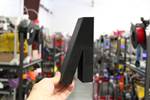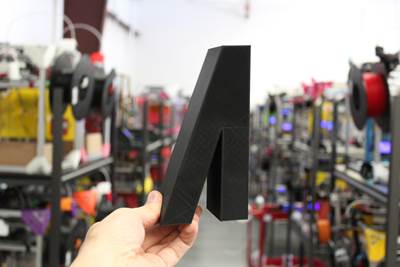A machine shop would probably not invest time and energy in developing its own machine tool for cutting metal. For a mature industry like machining, the equipment needed likely already exists. Yet, equipment built in-house is a phenomenon relatively common among additive manufacturers: Companies 3D printing end-use parts and products are often also the producers of the 3D printers used in that production.
What does this say about the state of additive manufacturing? Why are AM users inclined, inspired or driven to develop their own 3D printers and printing technologies? Editors Stephanie Hendrixson and Julia Hider share examples (like furniture company Model No., developer of the large-format 3D printer being worked on in the photo above) and discuss the reasons for homegrown 3D printers in the latest episode of the AM Radio podcast. Listen above or read on for the transcript.
Transcript
Julia Hider
Welcome to AM Radio, the show where we tune in to what’s really happening in additive manufacturing. I’m Julie Hider, and on today’s episode, Stephanie Hendrixson and I will talk about why companies are deciding to build their own 3D printers. Then I’ll talk to her all about how additive manufacturing is going green. That’s coming up on AM Radio.
Stephanie Hendrixson
The AM Radio Podcast is brought to you by the Additive Manufacturing Conference and Expo, the leading industry event focused on 3D printing for production plan to join us October 12 through 14th at the Duke Energy Center in Cincinnati, Ohio. Learn more at AdditiveConference.com.
Julia, thanks for joining me on the podcast today.
Julia Hider
I’m glad to be here.
Stephanie Hendrixson
So for our first segment, I want to talk about this trend that I’ve noticed — companies in additive manufacturing that decide to build their own 3D printers. And I’m talking specifically about companies that build their own printers not to sell, but to use in their own production. And I want to see if we can talk about why that is.
Julia Hider
Yeah.
Stephanie Hendrixson
So, let me just give you a couple of examples real fast here. These are both California companies. The first is Gantri, which is a company that makes lamps. And it’s sort of like Etsy, if Etsy made all of the products that you can buy on Etsy. So they are a 3D printing facility that works with designers. And so the designers are able to list their products on the website, and then Gantri handles all the production and shipping. And from the very beginning, they were 3D printing these lamps on demand, actually a little bit before on demand. And they started off with just off-the-shelf 3D printers, but they pretty quickly realized that they needed to be able to produce things that were taller than what they could get with those original printers. So they designed their own printer. It’s called the Dancer, and it can print up to two feet tall. And they just use it for their own production.
A similar situation, there's a company called Model No. also in California that makes furniture and they use a combination of hardwood that they machine with a router, and then PLA that they print with their own printers. And sort of similar, they were looking for something that had a really big build volume that could build the base of a table, that could build a chair or something like that. And they couldn't find anything that they liked, that was sort of in the right price range and that was big enough and that was gonna let them use any material that they wanted to. So they invested all this this time and energy into building their own large-scale 3D printers. And what I think is interesting in both of these cases is that these companies develop these 3D printers, which is, you know, not an easy undertaking. And they've put all this work into them, but they're not interested in selling those 3D printers. They just want to use the printers they've made to make the product that they originally conceived of. And I wonder if that rings a bell with you, if you've seen an example of a company, building their own machines like that?
Julia Hider
Yeah, so I have recently visited a company called IC3D in Columbus, Ohio. And they actually started with the founder, Michael Cao, he was building desktop 3D printers in his basement and selling them on eBay. But it was just a side hustle for him. And eventually, in 2014 or so a bunch of other desktop FDM printers hit the market. And because it was a side hustle, I mean, he couldn't keep up. So he pivoted to making filament for 3D printing. A few years later, he was able to join the company full time, and they decided to launch a service bureau in addition to the filament production. So when they were building out this service bureau side of their business, they had to decide what kind of 3D printer they were going to use. And the way they saw it, they had two basic options, they could go with desktop hobbyist-type 3D printers, or they could invest in a more expensive system. But he said that when he looked at the numbers, neither of those options really made sense for the type of work they were wanting to take on. The desktop printers would require too much tinkering. And the more expensive systems didn't really make sense for the type of price-sensitive like tooling and prototyping work that they were looking to do. So the most economical option was for them to build their own 3D printers. And luckily, he had experience doing that. And at first, they were just building printers for their own internal in-house use. But earlier this year, they actually launched a separate commercial 3D printer called the Virago, so they’ve kind of come full circle again.
Stephanie Hendrixson
Wow. Yeah. So going from printer manufacturer to filament to parts, and then finding your way back to build the building the printers for their own use. And then, and then also to sell. That kind of reminds me of another example. So, there’s a company that I wrote about last year in Idaho called Slant3D. And they have like two massive printer farms near Boise, I think something like 800 printers spread across two facilities. And they, again, like started with desktop printers, they were trying to, to start making parts and making prototypes and things. And pretty quickly realized that if they wanted to scale the technology, they needed more automation, they needed some different options that they weren’t able to find off the shelf. And so they made the investment in figuring out how to be a printer manufacturer. And so they’ve, they’ve developed their own printers, like all of the ones that they’re using for production now, I believe, are their own design. And similar to IC3D like part of it’s economics, and part of it’s lead time. They realized that if they controlled the production of the printer, they could much more easily get new printers up and running. The design they have now, it takes them like four hours to assemble a new printer. So if they for some reason needed to scale up pretty rapidly, like they could do that. They wouldn’t have to wait on shipping or a supplier to get back to them. They can control the production by controlling the printers.
Julia Hider
You know, all of the examples that we’ve given so far are polymer. Do you have any examples of metal 3D printers that companies have made for themselves?
Stephanie Hendrixson
Yeah, so I have seen this happen on, on the metal side. So, like, one example that comes to mind is 3DEO. They’re in California, and they’ve developed a metal printing technology. And I believe the original concept for the company was that they would create these printers and they would sell them, but as they got to developing it, they decided, you know, actually, “We’d rather be a parts manufacturer.” So they kept the capacity in house, and they started producing parts. And you see that with some other companies as well, like specifically metal DED somehow lends itself to this, I think. I recently visited Lincoln Electric, in Cleveland, which they are very well known for their welding expertise. They sell welders, they sell the materials that you need, they sell automated welding systems. And they were able to kind of swing all of that knowledge into a metal 3D printing platform. And so now they have 18, 19 of these robot printing cells running in their facility. And they are just making parts for customers. They’re not really interested right now at least in selling the platform. Because as soon as you introduce a product like that to the market, you also need a customer service business, you need people who can go out and service the machines, you need people who can troubleshoot. And for them, it makes a lot more sense right now to keep the capacity in house, work out the kinks themselves. And then maybe down the road, they’ll sell the platform, but for right now, they’re, they’re really just focused on being a parts producer through their own systems.
Julia Hider
So why do you think this happens, Stephanie?
Stephanie Hendrixson
So I think we, we’ve talked through a couple of different reasons to do this. So the build volume, like maybe you can’t find exactly the right size printer in exactly the price point you want to pay. I think materials has something to do with it, certainly for for Model No. and for maybe some of these other examples. If you want an open platform where you want to do interesting things with maybe reusing, recycling, you might want to make your own printer for that reason. There’s wanting the automation, like wanting features that are not commonly available. And then there’s also the process control. If you control the printer, then you control the process better. You can, again, scale up by by making more printers when you need them, and introduce features that maybe you’re not going to find off the shelf.
Julia Hider
Yeah, I think this is a really interesting point that’s unique to additive. I can’t think of any, you know, subtractive manufacturers who have built their own machine tools and use them or sold them.
Stephanie Hendrixson
Yeah, that’s a good point. There’s something about additive that, I don’t know, maybe encourages creativity or maybe it’s just not a mature industry yet. And so, people see these gaps in the market and sometimes the best solution is to just fill it yourself. Make it yourself.
Julia Hider
You want it done right, you have to do it yourself.
Stephanie Hendrixson
Exactly. Alright if you want to learn. Alright, if you want to learn more about any of the companies we’ve talked about here, check out the links in the show notes or just go to AdditiveManufacturing.Media.
Julia Hider
Stay tuned after the break. We’ll talk about sustainability and additive manufacturing.
Stephanie Hendrixson
The AM Radio podcast is brought to you by the Additive Manufacturing Conference and Expo. The leading industry event focused on 3D printing for production. The conference takes a practical, applications-based look at the machines, materials and methodologies being used to create end-use tools and components. The event is designed for owners, executives and engineers in manufacturing as well as OEMs involved in durable goods production. Join the Additive Manufacturing team in Cincinnati, Ohio for two days of in-depth conference sessions, exhibits and plenty of networking opportunities with AM experts. Also on the expo floor, check out the finalist entries in The Cool Parts Showcase, a contest to find the next subjects of our video series, The Cool Parts Show. Be sure to vote on your favorite. The Additive Manufacturing Conference and Expo runs October 12 through 14th. Find all the details and register at AdditiveConference.com.
Related Content
DMG MORI: Build Plate “Pucks” Cut Postprocessing Time by 80%
For spinal implants and other small 3D printed parts made through laser powder bed fusion, separate clampable units resting within the build plate provide for easy transfer to a CNC lathe.
Read More8 Cool Parts From Formnext 2024: The Cool Parts Show #78
End-use parts found at Formnext this year address various aspects of additive's advance, notably AM winning on cost against established processes.
Read MoreTwo 12-Laser AM Machines at Collins Aerospace: Here Is How They Are Being Used
With this additive manufacturing capacity, one room of the Collins Iowa facility performs the work previously requiring a supply chain. Production yield will nearly double, and lead times will be more than 80% shorter.
Read MoreBeehive Industries Is Going Big on Small-Scale Engines Made Through Additive Manufacturing
Backed by decades of experience in both aviation and additive, the company is now laser-focused on a single goal: developing, proving and scaling production of engines providing 5,000 lbs of thrust or less.
Read MoreRead Next
Angled Makes It Possible for Anyone to Launch a 3D Printed Product
The online store utilizes open capacity at its sister 3D printer farms for on-demand production with no startup costs, allowing designers to sell physical products as easily as digital ones.
Read MoreMaterials are Key to 3D Printed Injection Mold Tooling
IC3D’s combination of experience with filament production, building 3D printers and service bureau work is helping it expand the possibilities of 3D printed injection mold tooling.
Read MoreGantri’s 3D Printed Luxury Lighting Brings Designers Closer to Consumers
The San Francisco startup is changing designer lighting with a designer-forward online marketplace and just-in-time delivery enabled by 3D printing.
Read More

.jpg;width=70;height=70;mode=crop)



















